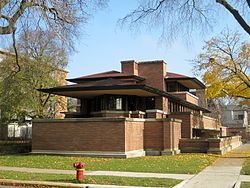Robie House
|
Frederick C. Robie House
|
|

The Robie House
|
|
| Location | 5757 South Woodlawn Avenue, Chicago, Cook County, Illinois |
|---|---|
| Coordinates | 41°47′23.4″N 87°35′45.3″W / 41.789833°N 87.595917°WCoordinates: 41°47′23.4″N 87°35′45.3″W / 41.789833°N 87.595917°W |
| Area | 0.3 acres (0.12 ha) |
| Built | 1909 |
| Architect | Frank Lloyd Wright |
| Architectural style | Prairie style |
| NRHP Reference # | 66000316 |
| Significant dates | |
| Added to NRHP | October 15, 1966 |
| Designated NHL | November 27, 1963 |
| Designated CL | September 15, 1971 |
The Frederick C. Robie House is a U.S. National Historic Landmark on the campus of the University of Chicago in the South Side neighborhood of Hyde Park in Chicago, Illinois, at 5757 S. Woodlawn Avenue. Built between 1909 and 1910, the building was designed by architect Frank Lloyd Wright and is renowned as the greatest example of the Prairie School style, the first architectural style considered uniquely American. It was designated a National Historic Landmark on November 27, 1963 and was on the very first National Register of Historic Places list of October 15, 1966.
Wright designed the Robie House in his studio in Oak Park, Illinois between 1908 and 1909. The design precedent for the Robie House was the Ferdinand F. Tomek House in Riverside, Illinois, designed by Wright in 1907-08. At the time that he commissioned Wright to design his home, Robie was only 28 years old and the assistant manager of the Excelsior Supply Company, a company on the South Side of Chicago owned and managed by his father. Although later drawings of the Robie House show a date of 1906, Wright could not have started the design for the building earlier than the spring of 1908 because Robie had actually purchased the property only in May of that year. He and his wife, Lora Hieronymus Robie, a 1900 graduate of the University of Chicago, had selected the property at 5757 South Woodlawn Avenue in order to remain close to the campus and the social life of the University. The property was a typical urban lot in Hyde Park, measuring 60 feet (18 m) by 180 feet (55 m).
The contractor for the project, H.B. Barnard Co. of Chicago, began construction on April 15, 1909. Wright did not supervise the construction of the house except in the earliest stages. He closed his Oak Park studio in the fall of 1909 and left for Europe to undertake the work which led to the publication of the Wasmuth Portfolio. He turned over his existing commissions to Hermann von Holst, who retained Marion Mahony, a draughtswoman in Wright's office, and George Mann Niedecken, an interior designer from Milwaukee, Wisconsin who had worked with Wright on the Susan Lawrence Dana House in Springfield, Illinois, the Avery Coonley House in Riverside, Illinois, and the Meyer May House in Grand Rapids, Michigan, to continue their work on the project. Niedecken's influence can be seen in the design of some of the furnishings for the house as well as the carpets in the entrance hall, the living room, and the dining room.
...
Wikipedia



